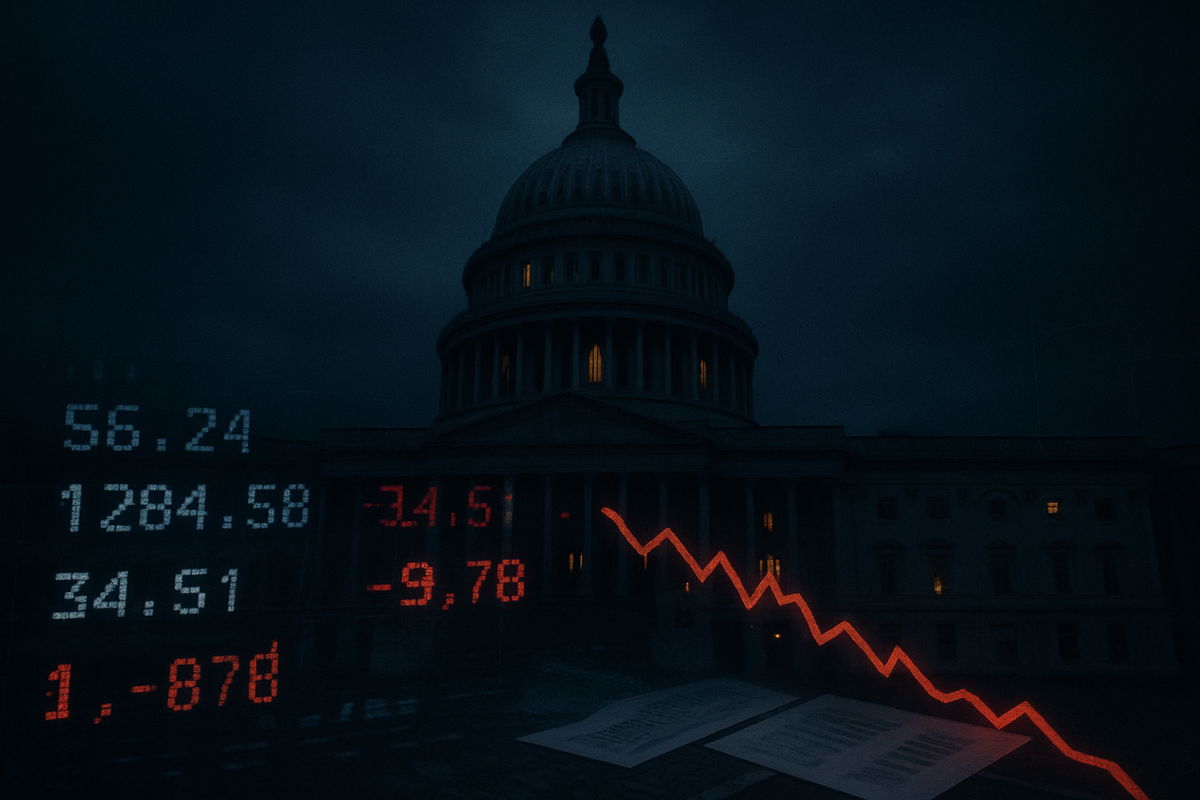
The specter of a U.S. government shutdown once again casts a shadow over financial markets, threatening to inject a fresh wave of uncertainty and volatility into an already sensitive economic landscape. As the deadline for congressional funding approaches, investors are bracing for potential disruptions to market performance, the delay of critical economic data, and a palpable shift in market sentiment. While historical precedents suggest that the broader market impact might be temporary, the immediate implications for specific sectors and the overall economic outlook warrant close scrutiny.
A shutdown, even a brief one, can trigger a "risk-off" environment, leading to initial market jitters and a scramble for safe-haven assets. Beyond the immediate stock market reactions, a more profound concern lies in the potential halt of vital economic reporting from federal agencies. This disruption can leave investors and policymakers "flying blind," complicating assessments of the nation's economic health and potentially influencing critical monetary policy decisions by institutions like the Federal Reserve.
Historical Echoes: Understanding Past Shutdowns and Their Market Repercussions
The current U.S. government shutdown, which commenced on October 1, 2025, after congressional Democrats and Republicans failed to reach an agreement on a funding package, is not an unprecedented event in American history. While each shutdown carries its unique political motivations and economic backdrop, historical precedents offer valuable insights into how markets typically react.
One of the most significant shutdowns occurred from December 22, 2018, to January 25, 2019, lasting a record 35 days. This protracted standoff under President Donald Trump, driven by demands for border wall funding, initially saw the S&P 500 (SPX) dip by 2.7% on the first trading day. However, the market demonstrated remarkable resilience, rebounding sharply and ultimately gaining over 10% by the shutdown's conclusion. Similarly, the 2013 shutdown, a 16-day event fueled by disputes over the Affordable Care Act under President Barack Obama, saw the S&P 500 (SPX) initially slip but ultimately advance by 3.1% over its duration. Even the two shutdowns in 1995-1996, under President Bill Clinton, saw the S&P 500 (SPX) experience a mild dip but recover quickly.
These historical trends suggest that while initial volatility and a "risk-off" sentiment are common, the broader market impact of government shutdowns has often been temporary. Investors tend to look beyond the political theatrics, focusing instead on underlying economic fundamentals and the expectation that a resolution will eventually be reached. However, the current shutdown introduces a new variable: reports that the White House is considering permanent layoffs for furloughed workers, a departure from past practices where back pay was typically guaranteed. This could potentially lead to a more pronounced market reaction if sentiment deteriorates significantly. Despite this, as of October 4, 2025, major indices like the Dow Jones Industrial Average (DJI), S&P 500 (SPX), and Nasdaq-100 (NDX) have shown a paradoxical resilience, even hitting fresh records, with much of the momentum attributed to factors like artificial intelligence and interest rate cut expectations.
Corporate Fortunes: Winners and Losers in a Shutdown Scenario
The ripples of a U.S. government shutdown extend far beyond the halls of Washington, creating a complex web of winners and losers across various sectors of the public market. Companies with deep ties to federal funding, regulatory processes, or government employee spending are often the most vulnerable, while others, particularly those in essential services or defensive plays, may weather the storm with greater ease, or even see indirect benefits.
Federal contractors, especially those in defense, IT, and infrastructure, face direct and immediate headwinds. Companies like Oracle (NYSE: ORCL), which derive a significant portion of their sales from federal government contracts, can experience suspended or delayed projects and payment disruptions. Unlike federal employees, contractors are typically not guaranteed back pay, leading to potential revenue losses and cash flow challenges. Similarly, the aerospace and aviation sectors are heavily impacted. The Federal Aviation Administration (FAA) furloughs many employees, delaying safety certifications, aircraft inspections, and the integration of new technologies. This can directly affect airlines such as Delta Air Lines (NYSE: DAL), which may face delays in putting new aircraft into service, alongside reduced travel from government employees.
The healthcare sector, while maintaining mandatory programs like Medicare and Medicaid, sees disruptions in discretionary-funded services, new drug application approvals by the FDA, and research at the NIH. The financial services industry also faces significant regulatory bottlenecks, as agencies like the SEC operate with minimal staff, slowing approvals for IPOs, mergers & acquisitions, and other critical transactions. This can put a freeze on capital flows for emerging technology companies and delay high-profile initial public offerings. Small businesses, particularly those reliant on federal loans or catering to government employees, also face immediate financial uncertainty.
Conversely, certain sectors and companies are more insulated or even benefit. Mandatory spending programs like Social Security and Medicare continue without interruption, meaning that the beneficiaries of these programs are not immediately impacted. Large defense contractors with long-term, pre-funded national security initiatives, such as Northrop Grumman Corp (NYSE: NOC), are often shielded due to the essential nature of their work. Consumer staples and discount retailers, like Walmart Inc (NYSE: WMT), may see stable or increased demand as consumers prioritize essential goods and seek value during times of economic uncertainty. Utilities, providing indispensable services like electricity and water, also tend to be resilient. Furthermore, during periods of political and economic instability, safe-haven assets like gold often see increased demand, potentially benefiting gold mining companies such as Newmont Corporation (NYSE: NEM).
Wider Significance: Beyond the Immediate Impact
The current U.S. government shutdown, though exhibiting historical patterns of market resilience, carries a wider significance that extends beyond immediate stock market fluctuations and delayed economic reports. It underscores deeper fragilities within the American political system, potentially exacerbating existing industry trends, creating regulatory paralysis, and subtly eroding global investor confidence.
One significant ripple effect is the disruption to regulatory processes. Agencies like the Securities and Exchange Commission (SEC), Food and Drug Administration (FDA), and Environmental Protection Agency (EPA) operate with minimal staff, creating bottlenecks for IPO approvals, drug trials, environmental permits, and mergers and acquisitions. This regulatory slowdown can significantly hinder innovation and investment, particularly in sectors like biotech and clean energy that rely heavily on timely government approvals. For international businesses, delays in obtaining necessary permits or navigating trade regulations can slow market entry and investment in the U.S., impacting global trade and cross-border transactions. Agencies involved in export controls and foreign investment, such as the Committee on Foreign Investment in the United States (CFIUS), also experience significant delays, injecting uncertainty into global M&A activity.
Historically, government shutdowns have generally had a muted and short-lived economic impact, with much of the lost activity typically recouped once the government reopens. The Congressional Budget Office (CBO) estimated that the 16-day 2013 shutdown subtracted 0.3 percentage points from annual GDP, while the 35-day 2018-2019 shutdown reduced GDP growth by 0.1-0.2 percentage points in the affected quarters. However, the current political climate, characterized by deep divisions and an economy potentially more vulnerable to external shocks, may amplify these effects. The discussion around potential permanent layoffs for furloughed federal workers, a departure from past practices of guaranteed back pay, could make this shutdown more consequential, eroding consumer spending and confidence more severely.
Furthermore, a prolonged shutdown sends a damaging signal about political dysfunction in the world's largest economy, which can subtly erode trust in U.S. governance and fiscal stability among international investors. While the U.S. dollar may experience initial weakness, its reserve currency status often limits prolonged depreciation, and it could even strengthen if the shutdown coincides with broader global economic uncertainty, as investors still seek safe havens. The delay in releasing key economic data also creates a "market data blind spot" for policymakers, including the Federal Reserve, complicating crucial monetary policy decisions and potentially adding another layer of uncertainty to global financial markets.
What Comes Next: Navigating the Uncertainty
The current U.S. government shutdown, commencing on October 1, 2025, injects a layer of profound uncertainty into both the short-term economic outlook and the longer-term trajectory of financial markets. While historical data often points to a temporary impact, the unique circumstances of this shutdown, coupled with existing economic vulnerabilities, demand careful consideration of what lies ahead.
In the short term, the immediate economic impact is a reduction in GDP growth, with estimates suggesting a weekly hit to the economy. Furloughed federal workers and delayed government procurement will weigh on consumer spending and business activity. For businesses, particularly those with government contracts, strategic pivots are paramount. Diversifying revenue streams beyond federal reliance, fortifying supply chains against potential disruptions, and maintaining robust cash reserves are crucial adaptations. Companies in regulated industries must prepare for prolonged delays in approvals and permits, necessitating proactive communication and scenario planning. The stock market is likely to experience continued short-term volatility, with sectors heavily dependent on federal contracts or regulatory approvals facing particular headwinds.
Looking further ahead, the long-term consequences hinge critically on the shutdown's duration. A swift resolution would likely see a quick recuperation of lost economic activity, as has been the historical norm. However, a prolonged impasse could lead to more significant and lasting damage, potentially eroding consumer confidence, causing permanent job losses beyond temporary furloughs, and even altering global perceptions of the U.S. dollar's reliability as a safe haven. This could encourage international investors to diversify into non-U.S. assets, impacting capital flows and potentially strengthening other major currencies.
A critical player in this unfolding scenario is the Federal Reserve. The shutdown significantly complicates the Fed's data-dependent policymaking, as key economic reports like employment figures and inflation data are delayed or suspended. This "flying blind" scenario introduces considerable uncertainty into decisions regarding interest rate adjustments. While some analysts suggest the Fed might still proceed with planned rate cuts based on alternative data, the absence of comprehensive official data makes their task more challenging. Investor sentiment, already a fickle beast, will become even more volatile and reactive, driven by frustration and uncertainty. While seasoned investors may seek opportunities in market dislocations, for many, the advice will be to rebalance portfolios, prioritize quality holdings, and maintain liquidity.
Comprehensive Wrap-up: Assessing the Market Moving Forward
The U.S. government shutdown, now underway as of October 4, 2025, serves as a stark reminder of the intricate link between political stability and economic health. While historical precedents suggest that the broader market impact of such events is often temporary, the current situation presents a unique blend of immediate disruptions and potential long-term implications that demand vigilance from investors.
Key takeaways from this event include the immediate increase in market uncertainty and volatility, particularly affecting sectors reliant on federal funding and regulatory processes. The delay in critical economic data creates a significant "blind spot" for both investors and policymakers, complicating accurate assessments of the nation's economic health and potentially influencing the Federal Reserve's monetary policy decisions. While major indices have shown a surprising resilience in the face of the current shutdown, this should not breed complacency, as a prolonged impasse could erode confidence more deeply.
Moving forward, the market's trajectory will largely be determined by the duration of the shutdown and the nature of its resolution. A swift and amicable agreement would likely lead to a quick recovery of market confidence and economic activity. However, a protracted and contentious shutdown risks exacerbating existing economic vulnerabilities, potentially leading to more significant job losses and a sustained drag on consumer spending.
Investors should watch closely for any developments regarding the shutdown's resolution, paying particular attention to the terms of any agreement and its potential impact on federal spending and regulatory environments. Monitoring the Federal Reserve's communications will be crucial, as they navigate a data-scarce environment to make critical policy decisions. Furthermore, keeping an eye on the performance of sectors heavily exposed to government contracts versus those providing essential services or acting as safe havens will provide valuable insights into market sentiment. While the immediate instinct might be to react to daily headlines, a long-term, diversified investment strategy remains paramount, with an emphasis on companies with strong fundamentals and resilience to political and economic shocks.
This content is intended for informational purposes only and is not financial advice






